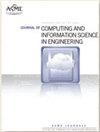Combinational Framework for Classification of Bearing Faults in Rotating Machines
IF 2.6
3区 工程技术
Q2 COMPUTER SCIENCE, INTERDISCIPLINARY APPLICATIONS
Journal of Computing and Information Science in Engineering
Pub Date : 2023-05-03
DOI:10.1115/1.4062453
引用次数: 0
Abstract
In rotating machines, roller bearings are important and prone to frequent faults. Hence, accurate classification of bearing faults is significant in maintenance of machines. Towards this, a framework using the combination of signal processing, machine learning and deep learning algorithms has been proposed in contrast to traditional approaches. The benefits of each algorithm have been reaped in the proposed framework to overcome challenges met in fault identification. In this, Ensemble Empirical Mode Decomposition is applied on bearing vibration signals to reduce non-stationarity and noise. The 12 Intrinsic Mode Function (IMF) signals of 24k length obtained for 3 bearing conditions at 4 speeds constituted feature space of dimension [36*8*24000]. IMFs that have highest correlation coefficient with raw vibration signals are selected as features [3*8*24000] and intelligent algorithms are applied. Application of Principal Component Analysis on selected IMF feature space resulted in extraction of significant features retaining temporal characteristics along 2 major components [3*2*24000]. Considering the temporal dependence of faults in signals, a Stacked Long Short Term Memory (LSTM) deep network is chosen and trained with extracted features to improve fault classification. The performance of this developed framework has been evaluated for different metrics of stacked LSTM model. The proposed framework also satisfactorily surpassed the performance of stacked LSTM model trained with raw data, capable of auto-feature learning. The comparative results inclusive of models in relevant literature illustrate efficacy of developed combinational framework in handling dynamic vibration data for precise classification of bearing faults.旋转机械轴承故障分类的组合框架
在旋转机械中,滚子轴承是重要的,容易发生频繁故障。因此,轴承故障的准确分类在机器维修中具有重要意义。为此,与传统方法相比,提出了一种结合信号处理、机器学习和深度学习算法的框架。该框架充分利用了各算法的优点,克服了故障识别中遇到的挑战。在此基础上,对轴承振动信号进行集成经验模态分解,以降低非平稳性和噪声。在4种转速下3种轴承工况下得到的12个24k长度的IMF信号构成了维数为[36*8*24000]的特征空间。选取与原始振动信号相关系数最高的imf作为特征[3*8*24000],并应用智能算法。对选定的IMF特征空间进行主成分分析,提取出沿2个主成分[3*2*24000]保留时间特征的重要特征。考虑信号中故障的时间依赖性,选择堆叠长短期记忆(LSTM)深度网络,并利用提取的特征对其进行训练,提高故障分类能力。针对不同的堆叠LSTM模型指标,对该框架的性能进行了评价。该框架还令人满意地超越了使用原始数据训练的堆叠LSTM模型的性能,能够自动学习特征。与相关文献模型的对比结果表明,所开发的组合框架在处理动态振动数据以精确分类轴承故障方面是有效的。
本文章由计算机程序翻译,如有差异,请以英文原文为准。
求助全文
约1分钟内获得全文
求助全文
来源期刊
CiteScore
6.30
自引率
12.90%
发文量
100
审稿时长
6 months
期刊介绍:
The ASME Journal of Computing and Information Science in Engineering (JCISE) publishes articles related to Algorithms, Computational Methods, Computing Infrastructure, Computer-Interpretable Representations, Human-Computer Interfaces, Information Science, and/or System Architectures that aim to improve some aspect of product and system lifecycle (e.g., design, manufacturing, operation, maintenance, disposal, recycling etc.). Applications considered in JCISE manuscripts should be relevant to the mechanical engineering discipline. Papers can be focused on fundamental research leading to new methods, or adaptation of existing methods for new applications.
Scope: Advanced Computing Infrastructure; Artificial Intelligence; Big Data and Analytics; Collaborative Design; Computer Aided Design; Computer Aided Engineering; Computer Aided Manufacturing; Computational Foundations for Additive Manufacturing; Computational Foundations for Engineering Optimization; Computational Geometry; Computational Metrology; Computational Synthesis; Conceptual Design; Cybermanufacturing; Cyber Physical Security for Factories; Cyber Physical System Design and Operation; Data-Driven Engineering Applications; Engineering Informatics; Geometric Reasoning; GPU Computing for Design and Manufacturing; Human Computer Interfaces/Interactions; Industrial Internet of Things; Knowledge Engineering; Information Management; Inverse Methods for Engineering Applications; Machine Learning for Engineering Applications; Manufacturing Planning; Manufacturing Automation; Model-based Systems Engineering; Multiphysics Modeling and Simulation; Multiscale Modeling and Simulation; Multidisciplinary Optimization; Physics-Based Simulations; Process Modeling for Engineering Applications; Qualification, Verification and Validation of Computational Models; Symbolic Computing for Engineering Applications; Tolerance Modeling; Topology and Shape Optimization; Virtual and Augmented Reality Environments; Virtual Prototyping

 求助内容:
求助内容: 应助结果提醒方式:
应助结果提醒方式:


